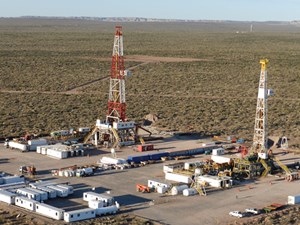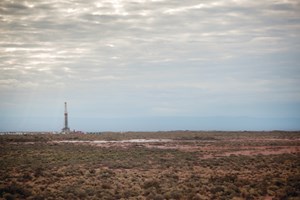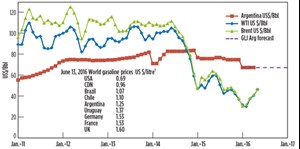ShaleTech: Argentina/Mexico shales
Perhaps nowhere in the emerging global unconventional landscape is the gulf between the haves and the wannabes wider than in Argentina and Mexico. While the former’s new president is working to make the country’s world-class shale reserves more competitive internationally, the latter just wants to get into the game.
To be sure, although Mexico’s most prospective shale basins reside on the doorstep of one of the premier U.S. plays, it is the much ballyhooed Vaca Muerta black shale that stretches more than 7.4 million acres beneath the oil and gas-rich Neuquén basin of west-central Argentina that many believe could eventually replicate much of the North American success. According to IHS Energy, the Vaca Muerta has the potential to be one of the most productive unconventional plays outside North America, providing the administration of President Mauricio Macri, who is nearing the end of his first year in office, is successful in enacting fiscal reforms, to improve the investment conditions in Argentina.
In Argentina, artificially propped up domestic oil and gas prices have been offset by well-documented fiscal and logistical challenges, including spiraling inflation and correspondingly high well costs, powerful unions and tight currency controls with restrictions on the free movement of cash.Macri is hoping to entice more international investment through a series of fiscal reforms, partially orchestrated to help spur development of what the U.S. Energy Information Administration (EIA) estimates are the world’s second-largest technically recoverable shale gas reserves (802 Tcf) and fourth-ranked shale oil reserves (27 Bbbl). “Argentina needs to bring to the table a more stable regulatory regime,” said Ricardo Bedregal, director for upstream research and consulting at IHS Energy. “The unions are among the main roadblocks keeping Macri from achieving what he wants to achieve.”
Bedregal, however, said one proposed government measure that should be enacted over time, rather than in one fell swoop, is the removal of production subsidies, which YPF SA told Bloomberg, on Sept. 22, it believes could be lifted by the end of 2017. “The government should not do abrupt changes in subsidies, otherwise it could kill some of the investments already made to prove up the Vaca Muerta potential.”
Thus far, Macri’s efforts have not gone unnoticed by the international community. “Mauricio Macri’s new government is sending out positive signals and seems to take a business-friendly approach,” said a spokesman for Germany’s Wintershall Holding GmbH, among the handful of international players not aligned directly with state-owned YPF. “The free-floating exchange rate creates competition—that is always good for the economy.”
BULLISH PATH
Geologically, the characteristics of the Vaca Muerta source bed stacks up or surpasses the most productive U.S. shale plays with documented thickness of more than 1,000 ft in places, average total organic carbon (TOC) between 3% and 10%, and reservoir pressures from 4,500 psi to 9,500 psi. Argentina also houses other strategic prospects, including the Lower Agrio shale and the diversified Loma Montosa carbonate tight oil formation.
By 2040, the Vaca Muerta could, conceivably, be producing up to 560,000 bpd of liquids and 6 Bcfgd, translating to cumulative production of 2.8 Bbbl and 33 Tcf of oil and gas, respectively, IHS Markit predicts in its “IHS Energy Vaca Muerta Insight Series: Supply Scenarios for Argentina’s Energy Future,” released in August. This base-case scenario would require annual investments of up to $8 billion for drilling and completions, with upwards of 140 rigs and 1,500 wells at peak production.
“There is a huge supply-chain opportunity in the Vaca Muerta for service companies to come in and build the necessary supply infrastructure to develop the play, and to help their operator customers by leveraging their unconventional play development and cost-reduction expertise that has been honed so successfully in the U.S. plays,” said Bedregal, co-author of the Vaca Muerta report.
Despite a government-subsidized oil price of $67.50/bbl, activity has shifted more toward exploitation of tight gas sands, primarily in the underlying Lajas formation. “We’re seeing a movement of companies going from the oil-prone areas to the gas-prone areas in the Vaca Muerta,” he said in an interview. “Right now, exploration and development of the (unconventional) oil prone areas of Vaca Muerta are uneconomical.”
Indeed, federally supported prices notwithstanding, Argentina has not been isolated from the travails of the global market. In its latest international tally, Baker Hughes recorded 70 rigs active onshore Argentina in September, down from 110 rigs in September 2015, Fig. 1.
“While not as severely impacted as North America, Argentina has not been immune to the challenging commodity price environment,” Fernando Aguilar, president and CEO of Canada’s Calfrac Wells Services, said in reporting second-quarter earnings. “Despite the challenging market conditions, Calfrac’s activity in Argentina for the remainder of the year is expected to be relatively consistent with 2015, as higher activity with new customers in southern Argentina is expected to partially offset the decline in oil-focused activity in the Neuquén region.”
YPF SETS TONE
With control of more than 3 million acres—some 40% of prospective Vaca Muerta acreage—YPF is Argentina’s largest producer by an unassailable margin and the bellwether for the broader industry trajectory.
In the most recent data made available, YPF reported second-quarter unconventional production of 51,600 boed, up modestly from gross shale production of 50,600 boed to close out 2015. During the second quarter, the YPF active rig fleet comprised 11 drilling and 10 workover rigs. With 22 new producers put onstream in the second quarter, YPF says it now has an aggregate 503 Vaca Muerta wells on production.
In keeping with its intention to increase tight gas production, YPF said the 16 Lajas formation wells hooked up to the lines during the quarter delivered 5.0 MMcfd. Elsewhere, YPF said the start-up of new compression systems for the Rincón del Mangrullo and Estación Fernández Oro areas helped increase gas production by 36.8% and 11.7%, respectively, compared to the first quarter of 2016.
YPF drilled 358 new wells in the first half of 2016, most of which were in the Neuquén basin, where much of its activity is centered on three fields (Loma Campana, El Orejanoa and La Amarga Chica) operated in separate JVs with Chevron, Petronas and Dow Chemical Co.
Moreover, YPF says it is “getting closer” to the $10 million/well cost target it set for the end of this year. Recent Loma Campana wells, completed with 18 frac stages, came in around $11 million/well, according to YPF.
Meanwhile, YPF also signed an agreement with Russia’s OAO Gazprom late last year and suggests more partnerships could be in the offing. “We don’t have the capital to develop the full Vaca Muerta ourselves,” Chief Executive Ricardo Darre told analysts in August. “We will open to partners, to new investors. We’re already in the trend of discussing with other companies or investors for beyond the three fields we’re operating now with Dow, Petronas and Chevron.”
A smattering of other international players, however, are operating outside the umbrella of the state-owned behemoth.
THE OUTLIERS
Buoyed by the new government’s intended direction, Exxon Mobil suggests that over the coming decades it could invest upwards of $10 billion in developing its Vaca Muerta holdings. “I am very encouraged by the changes that have occurred here in Argentina, with the change in government,” Chairman and CEO Rex Tillerson told Bloomberg in June.
Flash forward to late August, and the supermajor, through its XTO Energy subsidiary, began its first Vaca Muerta production pilot on the combined Bajo del Choique/La Invernada Block in the Neuquén basin. Exxon Mobil holds a 90% working interest in the block, with the remaining 10% held by partner Gas y Petróleo del Neuquén S.A. (GyP). As of now, the estimated $250-million pilot program will include five horizontal wells, early production facilities and a gas pipeline. Depending on the results, Exxon Mobil has indicated that it would drill an estimated 556 horizontal wells over 10–20 years to fully develop the asset, according to the Latin America Oil and Gas Monitor (LatAmOil).
Elsewhere, Wintershall is wrapping up its four-well 2016 horizontal Vaca Muerta drilling program on the Aquada Federal Block, where it now holds a 90% working interest in a JV with provincial-owned gas producer GyP. Wintershall drilled two vertical wells on the block in 2015, “to better characterize the Vaca Muerta formation and to obtain data,” the spokesman said. “These wells have been stimulated hydraulically and are on test-production. This year, we are drilling the first four horizontal wells to demonstrate the productivity of the reservoir.”
The spokesman said Wintershall is running a single rig, but added, “a future extended drilling campaign is under evaluation. Size and extent of this drilling campaign depends on the results of the evaluation.”
Pure-play operator Madalena Energy saw first-half 2016 production drop year-over-year to 2,714 boed from 3,569 boed on the more than 950,000 net acres it holds in the Neuquén and northern Noroeste basins. The Calgary independent holds varying interests in a cumulative 13 blocks prospective for unconventional and conventional targets, including the Vaca Muerta and Lower Agrio shales, as well as the Loma Montosa and Mulichinco oil and liquids-rich gas formations, respectively. Madalena has released no specifics on its 2016 activity, other than to say it is focusing on raising capital for a horizontal Vaca Muerta delineation program on its Coiron Amargo Block and Loma Montosa horizontal development drilling at Puesto Morales. Madalena also is seeking a JV partner to help develop its 50,595-net-acre Curamhuele Lower Agrio shale position in the Neuquén basin.
As things now stand, Madalena said in 2017 it will commence its planned development drilling program at Puesto Morales and initiate a multi-frac Vaca Muerta completion program on its Coiron Amargo holdings.
Elsewhere, Shell has provided no details of its plans for the Sierras Blancas and Cruz de Lorena Vaca Muerta Blocks it was awarded in 2015. The same for Total Austral, which last December signed a reported $300-million agreement with GyP for development of a 18,641-mi2 swath of the Vaca Muerta.
SCIENTIFIC APPROACH
As the Vaca Muerta remains largely in the exploration phase, YPF over the past year led a multi-disciplinary evaluation aimed at reducing costs while identifying the sweet spots and optimizing perforation and completion strategies. “YPF and other operators have been working on better understanding what the Vaca Muerta formation is all about and what it takes to really develop it,” says Eduardo Vélez, CARBO Ceramics’ Latin America sales manager.
To that end, MicroSeismic is on track for the December initiation of microseismic monitoring on four horizontal wells on two pads in the Neuquén basin, a spokesperson said. In late October, local partner UGA Seismic was in the process of installing the first permanent near-surface Buried Array monitoring and data acquisition system for “a major operator in Argentina.” Once the array is installed, MicroSeismic will begin life-of-field monitoring, which will include hydrofracturing visualization, as well as completions analysis and reservoir and refracture imaging.
Microseismic was but one diagnostic tool YPF employed as part of an integrated study conducted on a Neuquén basin well last year, in an effort to better estimate the hydraulic fracture height generated during frac operations, which has been identified as one of the major uncertainties in maximizing unconventional well production. In a SPE paper earlier this year, YPF discussed one test well that evaluated myriad diagnostic technologies, including the use of microseismic for far-field diagnostics.1 The same well also examined near-wellbore techniques, including time-lapse sonic and CARBO’s non-radioactive tracer (NRT) technology, which measures propped fracture height and confirms confinement of frac treatments within target boundaries.
“These have been more science wells with an integrated study to see how the fracture heights are growing in that formation,” said Pragnya Maruwada, CARBO NRT product champion. “The NRT was used initially to see where the fractures were going and determine ways to optimize the completion program based on the fracture heights.”

Mexico: Auction coming. Some 4,600 mi to the north, Mexico claims it is in the homestretch of finally putting its prospective shale acreage up for bids by second-quarter 2016. During a one-day confab on Oct. 10 in Mexico City, sponsored by World Oil’s sister publication, Petroleum Economist, Secretary of Energy Pedro Joaquin Coldwell said all pre-auction fiscal and regulatory guidelines should be in place by March.
EIA has estimated Mexico’s prospective shale blocks hold technically recoverable resources of 13.1 Bbbl of oil and 545 Tcfg, Fig. 2. The acreage had been scheduled to go out to bid last year, but officials shelved the offering, fearing little interest in the wake of continuing low oil prices. Perhaps owing to modest price improvements of late, Coldwell said the government is reacting to recent requests from operators to re-start the process.
In a preview of sorts, 25 mature onshore fields abutting the Texas border, in Central Mexico near the Gulf Coast and to the south near Campeché were awarded in December 2015. Mexican officials said that 21 of the fields offered hold less than 100 MMbbl of oil-in-place, and all but five were awarded to Mexican start-up companies, with Canada’s Renaissance Oil Corp. receiving three contracts as the only international operator without a Mexican partner.
Fellow Canadian operator International Frontier Resources Corp. of Calgary, in a 50-50 partnership with local petrochemical company Grupo Idesa, was awarded the Tecoluta Block in Veracruz, which has one well producing conventionally from the El Abra carbonate formation. Unconventional prospects, however, have been identified in the Taman and underlying San Andreas formations. A debut horizontal well is planned for the first half of 2017, the company says. ![]()
REFERENCE
- Ortiz, A.C., et al, “Hydraulic fracture height estimation in an unconventional vertical well in the Vaca Muerta formation, Neuquen basin, Argentina,” SPE paper 179145, presented at the SPE Hydraulic Fracturing Technology Conference, The Woodlands, Texas, Feb. 9-11, 2016.

- Shale technology: Bayesian variable pressure decline-curve analysis for shale gas wells (March 2024)
- Prices and governmental policies combine to stymie Canadian upstream growth (February 2024)
- U.S. producing gas wells increase despite low prices (February 2024)
- U.S. drilling: More of the same expected (February 2024)
- U.S. oil and natural gas production hits record highs (February 2024)
- U.S. upstream muddles along, with an eye toward 2024 (September 2023)
- Applying ultra-deep LWD resistivity technology successfully in a SAGD operation (May 2019)
- Adoption of wireless intelligent completions advances (May 2019)
- Majors double down as takeaway crunch eases (April 2019)
- What’s new in well logging and formation evaluation (April 2019)
- Qualification of a 20,000-psi subsea BOP: A collaborative approach (February 2019)
- ConocoPhillips’ Greg Leveille sees rapid trajectory of technical advancement continuing (February 2019)




